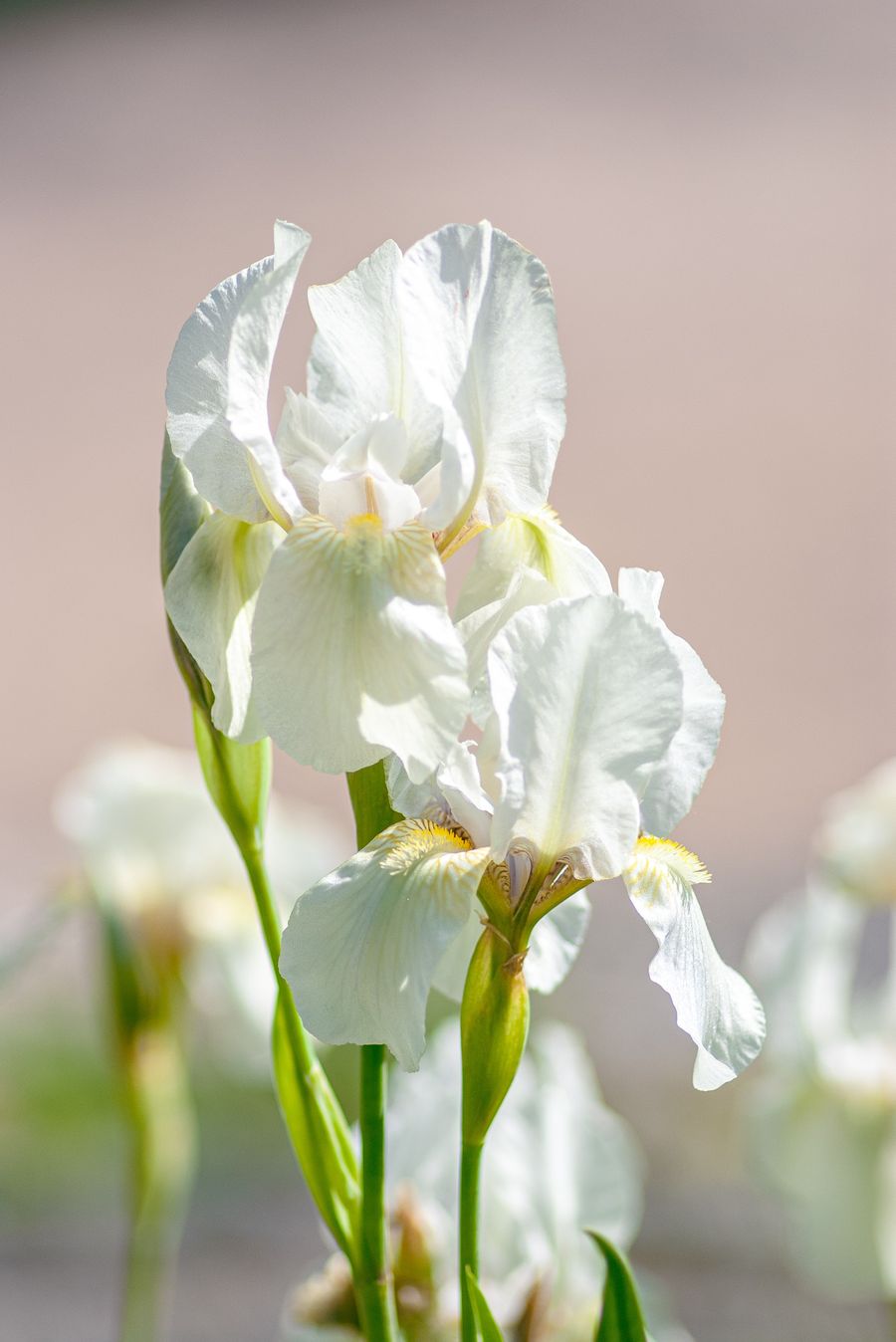Irises
by Grace Stapper
“The iris is the aristocrat of the gardening world. In temperament it is regal and unbending. The beauty and line of the flower is pure and wonderfully symmetrical. It is interesting for the modern gardener to know that the iris was well known to the ancient Greeks and Romans. The word Iris comes from the Greek, iris was the goddess of the rainbow. (Diana Beresford Kroeger)
“Perhaps the ultimate of garden magic is the unfolding of a bearded iris bud. The wonder is that a mere bud could hold such a spectacular flower’. (Roger E. Biles, The Complete Book of Garden Magic)
The species of iris that can be grown can match almost every gardening situation imaginable, from water gardens and bog gardens to acid, neutral or alkaline soils, to dry gardens and rock gardens. There are basically 3 types: bearded (rhizome), beardless (roots) and species (bulbs). Almost 300 species.

Bearded Iris grows best in temperate climates like ours, because they require winter dormancy. It allows the rhizome to convert the energy, which it collected all spring and summer through the plant’s foliage, into the production of new foliage and bloom stalks.
The (German) bearded irises have ‘brief but glorious blooming period’ (Lois Hole) Parts - falls are the 3 drooping petals, standards are the upright, beards are the fuzzy portion on centre of the falls (hairs guide insects toward the pollen and nectar) Orris powder is sourced from tall bearded iris and pallida iris. Used in perfumery and potpourri manufacture, gin, medicinal. Violet scented root, industry in Tuscany (Italy). Large flowers in wide range of colours, flat fan-like leaves. Colours are white, through pinks, yellows, biscuit colours, to purple and black. They come as bi-coloured, frilled and scalloped. Some are scented. Grow from rhizomes. They are classified as
1. Dwarf: Plant is small but flowers disproportionally large, 6-10’’
2. Intermediate: 15-17’’ b) picture of iris with 4 petals - unpredictable spring weather can make irises do weird things, eg. 4 petaling
3. Tall: 2-3.5 feet tall. They flower in the order of size - shortest to tallest. Plant in full sun. Don’t like wet areas. Divide every 3-4 years when flowers diminish.
Iris pallida ‘Variegata’ – Also called sweet bearded iris, 20’’ tall, green and ivory stripes, lavender-blue fragrant blooms. Striking foliage looks good all season, even in early spring.
Antique bearded iris – many antique irises have survived because they were so easily shared and ‘passed along’.
Reblooming – boast a second set of flowers in the fall. Many are the bearded types but also Japanese Siberians. Patience as they may need 2 years before they start blooming. White variety is named ‘immortality’.
Iris beardless or Apogon iris: Includes Siberian, Ensata (Japanese), Louisiana and Spuria irises.
Siberian iris: beardless 15-36’’ tall, have long and dense fibrous roots. Delicate looking flowers, tall stems and lasting grassy foliage. Bloom early June, a_er tall bearded iris has finished. Tolerates wet soil acidic conditions. Divide every 10 years. Among hardiest of all irises.
Water plants:
1. Iris versicolor – 2-3’ tall, native northern blue flag, found in marshes, wet ditches with acidic soil. Floral emblem of Quebec (1999). Debated: King Louis VII of France, named the iris (stylized flower, not likely lily) his ‘fleur-de-Louis’ in the 1100s, now fleur-de-lis, on the Quebec provincial flag.
2. Iris pseudacorus – 3-5’tall, yellow flag (alien, European), declared invasive, only yellow one likely to be found growing wild
3. Iris virginica – native N.A. perennial. Sun, acidic wet soil. Can be grown in shallow water. Light blue to violet colours, 2-2.5’ tall
Planting – division and planting diagram pg. 50, Basic Gardening Techniques. Best done after flowering, mid-August Plant rhizomes with back in the sunshine, ¾’’ out of soil. Rays of sun act as bacterial sterilant on rhizome and keep it healthy. Plant all rhizomes in same direction for more elegant display, 6-8’’apart. Plant so that flat side of leaves faces the direction from which you want to view the flowers. Cut flower stalk back to rhizome after flowering. Cuttng back leaves for appearance, affects the energy the plant absorbs, needed for next season’s blooms.
Problems:
1. Iris borer – in fall, a nocturnal, nondescript moth lays eggs on the outer leaves of the iris where they overwinter. The larva hatch in early spring and feed/tunnel into rhizome and cause leaves to yellow and wilt, changing into pupae in mid summer. Move into the soil and pupae hatch as moth in about a month, the new adults mate and lay their eggs. They seldom anack in locations where rhizomes have a chance to bake. Practice good sanitation. Lift clump, separate, discard decayed parts, replant. Add handful ground limestone to each group. Borers can be killed in spring before they reach the rhizome by pressing leaves together. Late August, trim leaves to 4” to foil borer.
2. Soft rot – bacterial disease often introduced by the borers, or soil that is too wet. Leaves rot at the base, rhizome becomes soft and foul smelling. Dig up and remove smelly parts, dust with sulphur or bleach. Replant in better drainage. Apply wood ashes.
3. In damp or overcrowded conditions, leaf spot disease may occur. Give thorough dusting with dry wood ashes.